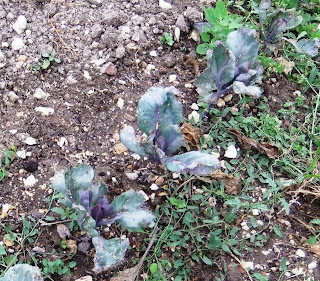 A tasty trugful.
A tasty trugful. One particular thing we noticed is the short harvest period for some crops. This was most true with the Petit Pois variety "Peawee" (available from Marshalls). I could pick a row on the allotment for about three weeks. Here the window between the mange-tout and marrowfat stages was about three days. Once the pods set, there were no more flowers. We picked the peas industrially, by uprooting the plants and stripping them, shelling them on the spot and freezing them.
 Scuse the gardener's hands!
Scuse the gardener's hands!Generally, summer brassicas have performed poorly, under attack from battalions of flea beetles and aphids. We know a song about flea beetles, don't we? Back in May I tried red cabbage and tenderstem broccoli, both hopeless!
 Disaster area featuring red cabbage and field bindweed.
Disaster area featuring red cabbage and field bindweed.The kales I planted recently are looking quite strong, and I hope they may do better. Red Russian Kale is a wonderful vegetable, highly decorative as well as excellent to eat, but I had to order it from the UK. Kings came up with the goods, bless them! Black Tuscan kale, by contrast, was on sale among the bedding plants at the Point Vert in Loches.


